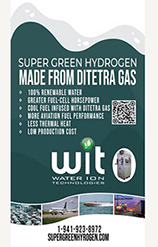 August 31, 2023 — Capturing hydrogen from electrolysis of either fossil fuels or water is extremely hot. The power grid to run the electrolyzers demands high intensity energy. It takes 0.146 kWh of DC electric current to produce 1 liter of hydrogen by high-temperature steam or the capture of hydrogen from fossil fuels using an industrial electrolyzer. Hydrogen fuel cells also generate extreme heat too.
August 31, 2023 — Capturing hydrogen from electrolysis of either fossil fuels or water is extremely hot. The power grid to run the electrolyzers demands high intensity energy. It takes 0.146 kWh of DC electric current to produce 1 liter of hydrogen by high-temperature steam or the capture of hydrogen from fossil fuels using an industrial electrolyzer. Hydrogen fuel cells also generate extreme heat too.
Reuters that is hosting the Hydrogen North America 2023 conference (Houston, October 11 – 12, 2023 and our R&D company, WIT International, is one of the exhibitors) states … “Goldman Sachs predicts an unparalleled market opportunity for hydrogen worth $11.7 trillion by 2050. In 2023 alone, the US Department of Energy is allocating $8bn. to the formation of hydrogen hubs across the nation.” Hydrogen hubs will lessen the transportation cost of hydrogen but the major challenge is the major power demand to capture hydrogen and solar power falls short on meeting the massive growing demand. Each solar panel only produces between 0.17 to 0.35 kWh.
DiTetra Gas (or dioxytetrahydride gas) yields five times more hydrogen using 10% of the energy when compared with other means of producing hydrogen. It takes 0.0028 kWh (Kilowatt hours) of DC electric current to produce 1 liter of dioxytetrahydride gas which yields 0.11 liter of hydrogen or 0.025 kWh for one liter of hydrogen. Plus the electric DC power to run the generator can come from either solar or wind. Assuming using a 0.17 kWh solar panel, one solar panel will make 60 liters of dioxytetrahydride gas which yields 6.6 liters of hydrogen. The same solar panel can only make 1.2 liters of hydrogen from electrolysis of either fossil fuel or water used to yield hydrogen. Another major attribute of DiTetra Gas is that the hydrogen is more active with additional electrons and can double the energy output of a hydrogen fuel cell. The cleaner, more active form of hydrogen made by green energy also will reduce thermal heat.
Using water like that used in making DiTetra Gas is renewable and does not create a deficit of critical oxygen levels in our air when the hydrogen fuel cells operate for energy.
Hydrogen definitely has its energy potential and distribution challenges. So does other forms of energy. One concern after the recent surge flooding from Hurricane Idalia in Western Florida is submerged cars with lithium batteries may have a malfunction or are at risk of fire. Batteries certainly have a place in the overall energy strategy but have their limitations in material supplies, environmentally-safe battery disposal, and power-grid capacity sufficient to recharge many batteries at a time. It is important to have multiple fronts on achieving less dependence on fossil fuels and provide proven research and safety before any new alternative fuel goes into the mainstream marketplace.
WIT International, the R&D company for Watt-Ahh bottled water, will be showcasing Super Green Hydrogen at Booth #7 during the Hydrogen conference to be held in coming October. The list of both conference sponsors and exhibitors at this conference can be found at this link.
